Effective Professional Development
Free webinar exploring the recommendations from the EEF’s effective Professional Development guidance report


Share on:

by Bradford Research School
on the
Mark Miller is Director of Bradford Research School
In our series looking at the mechanisms from the EEF’s Effective Professional Development guidance report, we’ve looked at Building Knowledge (Mechanisms one and two), Motivating Teachers (three, four and five), Developing Teaching Techniques (six, seven, eight, nine and ten).
Now we move on to Embedding Practice, with Mechanism 11: Providing prompts and cues. According to the guidance: “If embedding practice is missing, a teacher may understand the content, be motivated to improve, and have the techniques to do so but — after a period of time — may revert to old habits.”

Changing practice as a result of professional developments is essentially habit change. Wood and Rünger (2009) share three ways that prompts could support habit development:
A variety of cues might trigger habit performance, including aspects of physical environments, other people, and preceding actions in a sequence.
These three methods can be used by CPD leads to help embed changes in practice.
This can be as simple as a reminder of learning e.g. a follow up email with a summary of the main messages from PD. It could be something that builds on PD in setting some next steps or a prompt to try out something in particular. After a PD programme focusing on memory, for example, it could be followed up with some further reading, a reflection activity or a prompt such as ‘this week you should focus on the working memory demands of your activities.’
The ‘other person’ wouldn’t have to be the PD lead. Coaches, line managers or peers could also provide prompts. Many PD models have this built in e.g. lesson study.
If we become too reliant on these prompts from others, then there is a danger that new habits won’t be formed. So we can encourage people to self-regulate, and to essentially replace the prompts of the other person with self-directed prompts. Those who lead PD can also encourage self-monitoring, which we’ll come back to in a later blog.
In our blog on goal setting, we discussed implementation intentions. Setting these in the form of ‘if…then’ can set up a simple cue>action sequence. Goals without implementation intentions are less likely to be achieved. These can prompt positive actions e.g. If I have a pupil who cannot articulate the answer, I will bounce to another pupil then bounce back. Or they may be designed to avoid missing our goals e.g. we might say: And if I am tempted to ‘round up’ almost correct answers, I will ask another pupil to do so.
We can also use ‘when…then’. James Clear writes about ‘habit stacking’, which is attaching a new habit to an old one. His formula is After/Before [CURRENT HABIT], I will [NEW HABIT]. We take something that is part of our regular classroom practice, and ‘stack’ the new behaviour on top.
After I finish modelling, I will stop and ask ‘How successful was I and what could I change?’
After I have collected in the homework, I will set next week’s homework.
After I give instructions, I will move to the corner of the classroom and avoid speaking.
Taking time to define the routine occurrences that you can attach new habits to or irregular occurrences that require particular responses is a worthwhile use of PD time, and will automatically build in prompts and cues.
Physical environments are themselves prompts for particular behaviour. Think of the hushed tones you use in a library or the orderly queue you form at the post office.
The physical layout of a classroom can be set up to give prompts and cues. To encourage more pupil discussion, tables and chairs can be placed to facilitate. To prompt more circulation of the classroom, we could remove some barriers e.g. teacher’s desk. Reminders in the form of messages or posters at the back of the classroom wall can serve as a simple way to prompt a particular action.
In our last blog we wrote about rehearsal and practice, and it’s probably good to practice in the same context as you will be using the technique. Wood, Witt & Tam (2005) looked at the habits of college students when they changed context. In their conclusion, they write:
“When people practice an action, they develop associations in memory between the action and aspects of the context in which it typically occurs. With sufficient repetition in stable contexts, behaviour comes to be triggered relatively automatically by these features of the performance context.”
See the full list of mechanisms below, and the other blogs in the series.

Mechanism 1: Effective Professional Development: Managing Cognitive Load
Mechanism 2: Effective Professional Development: Revisiting Prior Learning
Mechanism 3: Next Goal Wins: Goal-setting in Professional Development
Mechanism 4: Research Says…
Mechanism 5: Praise in PD: Part of the Process; Part of the Culture
Mechanism 6: Professional Development: What Techniques and Why?
Mechanism 7: Professional Development: Practical Social Support
Mechanism 8: Modelling the technique
Mechanism 9: Providing Feedback
Mechanism 10: Rehearsing the Technique
Mechanism 11: Effective Professional Development: Prompts and Cues
Mechanism 12: Effective Professional Development: Action Planning
Mechanism 13: Effective Professional Development: Encouraging Self-monitoring
Mechanism 14: Effective Professional Development: Context Specific Repetition
Wood, W., & Rünger, D. (2016). Psychology of Habit. Annual review of psychology, 67, 289 – 314.Wood, Wendy & Witt, Melissa & Tam, Leona. (2005). Changing Circumstances, Disrupting Habits.. Journal of personality and social psychology.


Blog -
We share questions and resources to unpick the EEF’s Voices from the Classroom

Blog -
Investing in Subject Knowledge has Multiple Benefits

Blog -
Success is an important factor in motivation – how do we reconcile that with desirable difficulty?
This website collects a number of cookies from its users for improving your overall experience of the site.Read more